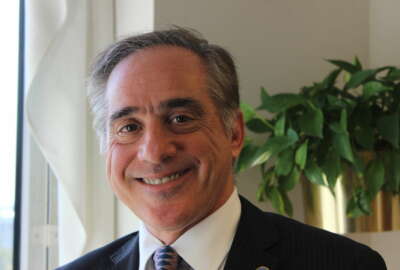
VA centralizing customer info in push for better service
The Veterans Affairs Department is creating a data backbone that will house veterans' addresses and correspondence in one system.
The Department of Veterans Affairs is trying to make it easier to communicate with veterans and keep track of their records.
VA is working on a system that will compile all of its customers’ names, addresses and correspondence, said VA Secretary Bob McDonald during a Nov. 6 speech in Washington.
“We are going to go to one data backbone, with one list of addresses, that like good customer service organizations keeps track of every interaction we have with our customers,” McDonald said at the National Press Club. “It’s going to cost money and it’s going to take time, but we’re going to do it.”
Currently, if a veteran changes addresses they must inform nine different areas of the VA, McDonald said.
McDonald said there was a timeline for the program, but declined to define it after the speech.
The announcement comes on the heels of a congressional hearing probing into the lack of health data interoperability at Veteran’s Affairs and Defense Department.
Lawmakers were disappointed with the lack of progress.
“Let me start today’s hearing by trying to simply state my frustration. It’s the year 2015, we live in a complex interconnected society with self-driving cars, wearable technology and complex algorithms that can predict when a critical mechanical component is going to break,” said Rep. William Hurd (R-Texas), chairman of the Oversight and Government Reform subcommittee on Information Technology. “But our soldiers, sailors, airmen and marines who are making the transition from DoD to VA health care on which we told to print out hard copies of their medical records and then walk them to the VA.”
Still, the “data backbone” is one of many new programs the VA is implementing to bring the department up to speed with current best practices.
“There is a lot of work to do,” McDonald said.
The push for better practices is led by VA’s Undersecretary of Health David Shulkin.
Shulkin is orchestrating an improvement to the VA’s Choice Program, which has helped fulfill veteran medical appointments through external providers.
The new plan goes beyond the Choice Program. Whereas now the VA tells patients to “go and find care anywhere,” Shulkin said, it will soon tell them to “find it among the best.”
“We need to have a formal system of care coordination so that we have the responsibility and know where vets are getting care, that they’re not getting gaps in care or that they’re not having missed appointments,” he said in an interview with Federal News Radio. “This is building an infrastructure to allow patients to get care seamlessly between the private sector and VA.”
The program is partly in response to the access problem VA is still cleaning up. As of Oct. 15, nearly 200,000 patients were told they had to wait at least two months longer for appointments than they preferred.
Former Secretary Eric Shinseki left last May after allegations surfaced that VA employees hid months long wait times that veterans faced when trying to receive care.
McDonald’s reforms have been part of a larger effort to better VA’s reputation after Shinseki resigned over the scandal.
Since then other VA scandals have come to light, including the harassment of whistleblowers within the department and possible criminal investigations into the wrongful use of a relocation funds.
Most recently, lawmakers have said they want to pass legislation that would make it easier for McDonald to discipline or fire employees.
Copyright © 2024 Federal News Network. All rights reserved. This website is not intended for users located within the European Economic Area.
Scott Maucione is a defense reporter for Federal News Network and reports on human capital, workforce and the Defense Department at-large.
Follow @smaucioneWFED
More from Federal News Radio:





